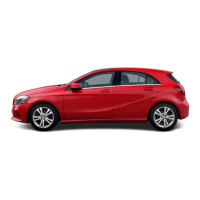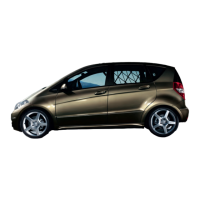Vehicle equipment
i
This Owner's Manual describes all models
and all standard and optional equipment of
your vehicle available at the time of publi-
cation of the Owner's Manual. Country-
specificdifferences are possible.Please
note that your vehicle may not be equipped
with all features described. This also
applies to safety-relevantsystems and
functions.
Occupant safety
Important safety notes
Seat belts, together with belt tensioners, belt
force limiters and airbags, are complemen-
tary, coordinated restraintsystems.They
reduce the risk of injury in specific, pre-
defined types of accident situations and
thereby increase occupant safety. However,
seat belts and airbags generally do not pro-
tect against objects penetrating the vehicle
from the outside.
To ensure that the restraint systems can
deliver their full potential protection, make
sure that:
R
the seat and head restraint are adjusted
properly (Y page 72).
R
the seat belt has been fastened properly
(Y page 38).
R
the airbags can inflate unrestricted if
deployed (Y page 34).
R
the steering wheel is adjusted properly
(Y page 72).
R
the restraint systems have not been modi-
fied.
i
An airbag increases the protection of
vehicle occupants wearing a seat belt. As
such they are only an additional restraint
system which complements, but does not
replace, the seat belt. All vehicle occupants
must wear their seat belt correctly at all
times, even if the vehicle is equipped with
airbags. Airbags are not deployed in all
types of accidents, e.g. in situations where
airbag deployment would not increase the
protection afforded by a correctly worn
seat belt. Airbag deployment only provides
increased protection if the seat belt is worn
correctly because:
R
the seat belt helps to keep the vehicle
occupant in the best position in relation
to the airbag.
R
in a head-on collision, for example, the
seat belt prevents the vehicle occupant
from being propelled towards the point
of impact and thus can reduce the risk of
injury.
Therefore, in accident situations where an
airbag is deployed, it only provides protec-
tion in addition to the seat belt if the seat
belt is being worn correctly.
G
Risk of accident and injury
If service work is not carried out correctly, the
operating safety of your vehicle may be affec-
ted. This could cause you to lose control of
your vehicle and cause an accident. More-
over, the safety systems may no longer be
able to protect you or others as they are
designed to do.
Always have service work carried out at a
qualified specialist workshop. The workshop
must have the necessary specialist knowl-
edge and tools to carry out the work required.
Mercedes-Benzrecommends that you use a
Mercedes-Benz Service Centre for this pur-
pose. In particular, work relevant to safety or
on safety-related systems must be carried out
at a qualified specialist workshop.
G
Risk of injury
Modifications to or work performed incor-
rectly on the following parts can result in the
restraint systems not functioning as intended:
R
the restraint system, consisting of seat
belts and their anchorage points, belt ten-
sioners, belt force limiters and airbags
R
the wiring
R
networked electronic systems
32
Occupant safety
Safety

